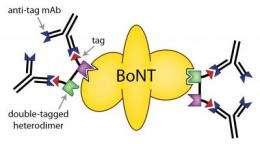Antitoxin strategy may help target other pathogens

Researchers have unveiled a novel strategy for neutralizing unwanted molecules and clearing them from the body.
The strategy employs chains of binding agents, like "beads on a string", which target two sites on one or more pathogenic molecules to neutralize their activity and promote their clearance by the body's immune system. The low-cost, easy-to-replicate tool has demonstrated applications against several different toxins, from those found in contaminated food to those used in bioterrorism, and may also prove effective in targeting other types of pathogens.
The research team, based at Tufts University's Cummings School of Veterinary Medicine, demonstrated the method's efficacy in preventing the symptoms of botulism, a rare but deadly disease caused by Clostridium botulinum neurotoxin (BoNT), considered one of the most dangerous bioterror threat agents. The findings were presented earlier this year in PLoS ONE.
"Currently, antitoxins are difficult to produce and have a short shelf life, making them very expensive. This new approach provides a low-cost way to develop highly effective antitoxins," said senior author Charles B. Shoemaker, PhD, professor of biomedical sciences at Tufts University's Cummings School of Veterinary Medicine.
"This method has the potential to target a number of pathogens – not only toxins such as BoNT, but viruses or inflammatory cytokines. It is an important platform through which to address other significant diseases," says co-author Saul Tzipori, BVSc., DSc, PhD, professor of biomedical sciences and director of the Division of Infectious Diseases at the Cummings School.
Shoemaker and team had earlier found that pools of small 'tagged' binding agents were highly effective in targeting toxins, neutralizing their function, and flagging them for removal via the body's immune system in the presence of an anti-tag monoclonal antibody.
In the newly published in vivo study, the researchers have advanced this approach by linking two BoNT-binding agents together and including two copies of the tag. The binding agents are small, stable proteins derived genetically from unusual antibodies produced by toxin-immune alpacas. The resulting molecule, called a 'double-tagged heterodimer,' binds to two separate sites on the toxin. Binding of this single heterodimeric agent much more effectively neutralizes the toxin than the unlinked monomer binding agents used in the prior research. In addition, attaching two tags to each of the two linked agents leads to toxin decoration by up to four anti-tag monoclonal antibodies, which promotes rapid toxin clearance from the blood, the researchers found (see figure).
The double-tagged heterodimer antitoxin agent strategy was shown to be efficacious against two types of BoNT in the PLoS ONE report. The antitoxin agents were administered at the time of exposure, or shortly after. Treated mice did not show any symptoms of botulism – including the lethal paralysis which characterizes the disease, even when exposed to high toxin doses. Thus, the benefits of complex antitoxins were equaled or bettered by administration of two easy-to-produce agents; a heterodimer binding agent and an anti-tag monoclonal antibody.
According to Shoemaker, a major advantage of this approach is that, unlike treatments that only neutralize toxins, this treatment both neutralizes toxins and ensures their rapid clearance from the body. "Agents that only neutralize their pathogenic target will eventually dissociate which will allow the pathogen to continue doing damage if it is not eliminated," he said.
The group has now successfully taken the research further by building longer strings of binding agents that target multiple toxins with a single molecule—for example, the two types of Shiga toxins that are produced by some E. coli found in contaminated foods or the two toxins produced by hospital-acquired C. difficile infections.
More information: Mukherjee J, Tremblay JM, Leysath CE, Ofori K, Baldwin K, et al. "A Novel Strategy for Development of Recombinant Antitoxin Therapeutics Tested in a Mouse Botulism Model." PLoS ONE 7(1): e29941. Published online January 6, 2012, doi: 10.1371/journal.pone.0029941















